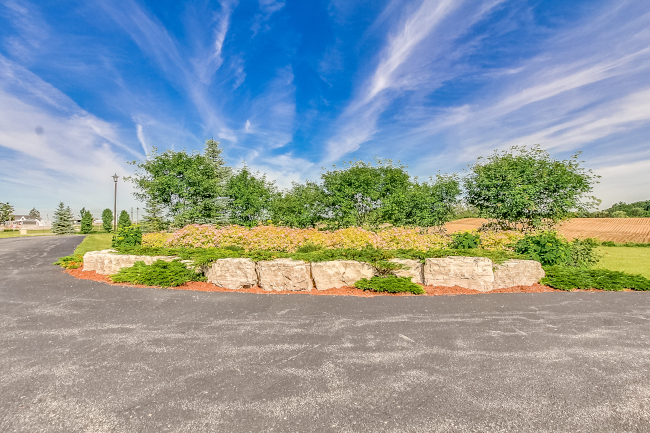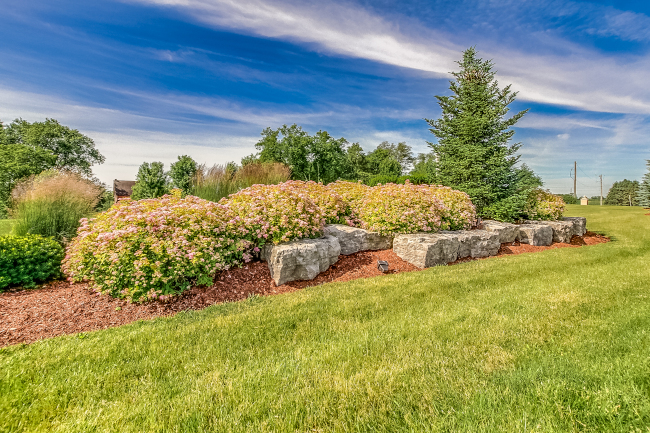If you’re wanting to make your property more sustainable and eco-friendly, your outdoor spaces are a great place to start. Making your yard more ‘green’ doesn’t only refer to the colour of your grass, in fact, the greenest lawns may not be eco-friendly at all as they require extensive amounts of water to achieve. From the inclusion of native plants and wildlife-friendly features to effective erosion control, green and sustainable landscape design can decrease your carbon footprint, help local flora and fauna thrive, and make your outdoor spaces gorgeous and low-maintenance. Read on to discover our top tips for achieving a healthy, environmentally friendly, and sustainable outdoor space that you and your family will love.
What is Sustainable Landscaping?
Sustainable landscaping (also often referred to as green or eco-landscaping) is an approach to the design, creation, and maintenance of your outdoor space with a focus on saving time, money, natural resources, and energy. Eco landscaping involves the use of multiple design techniques to create a space that thrives naturally and is also functional. Sustainable landscapes serve to nurture local wildlife, reduce pollution of the air, soil, and water and create safe and healthy outdoor recreation spaces. Your yard can make a major difference for local wildlife and pollinators, as well as local natural resources! A sustainable landscape should grow and thrive without the need for fertilizers or pesticides. It should also require limited water for its survival and be energy efficient.
Erosion Control
While the term ‘erosion control’ can conjure images of unattractive fixtures such as sandbags or silt fencing, it is possible to control erosion without sacrificing the beauty of your yard. You can spruce up your landscape and maintain the integrity of your grounds by using one of these erosion control options:
- Retaining Walls
- Terrace Gardens
- Dry Creek Beds
- Rain Gardens
- Ground Covers
- Swales
Controlling erosion is important to preserve valuable soil, which plays an essential role in each ecosystem. Did you know that half of the most fertile soil on the earth has been lost over the past two centuries, with erosion being the main culprit? Erosion can also contribute to the polluted storm and rainwater runoff that inevitably enters the local stream, river, and lake systems by dislodging soil that typically contains toxic pesticides and fertilizers.
Include Native Plants
You may have noticed an increase in popularity among gardeners and landscapers towards the inclusion of native plants in outdoor spaces.
Native species make ideal plants to include in yards and gardens because they have adapted over centuries to the area’s environmental conditions without the need for human intervention. Non-native plants, however, typically require more water, fertilizers, pesticides, attention, and specific conditions in order to thrive.
Xeriscaping
Xeriscaping involves the design of a landscape that requires little to no water (ideally the local rain levels provide adequate hydration). However, xeriscaping doesn’t involve turning your outdoor space into a barren desert. When well-designed, xeriscapes are beautiful and visually appealing landscapes that contain:
- Sand
- Drought-Tolerant Plants
- Mulch
- Permeable Hardscapes
Xeriscapes usually don’t include plants or grassy lawns that require lots of water. The more water that is conserved with a xeriscape, the more sustainable and eco-friendly your design will be.

Permeable Pavements:
Involves proper installation of base materials that allow surface water to be collected and evenly dissipate. The permeable materials can range from grass, gravel or crushed aggregate. These materials create a permeability that allows water to flow between the hardscape material itself. The hardscape mechanisms, combined with the permeable elements allow the water to simply drain through the pavement into either the ground water or into a reservoir. The water collected into the reservoir then can be used for irrigation systems or even water features, which reduces the use of supplied water.
Increase Energy Efficiency
A well-thought-out landscape design can increase the energy efficiency of the home and reduce energy costs. Here are some ways to achieve this in your landscape design:
- Plant deciduous trees to provide your home with shade, reducing costs related to cooling your home.
- Plant evergreen trees to block your home from frigid winter winds.
- Grow vines on wood trellises or brick walls to provide your home with additional insulation.
- Provide shade to your A/C unit with bushes or shrubs. The warmer the unit becomes, the harder it has to work to effectively cool your home.
Create a Wildlife Garden
You can increase the biodiversity of your outdoor space by creating a wildlife garden. A wildlife garden helps local wildlife by providing access to food, water, and shelter. The most successful wildlife gardens typically include:
- Wildflowers for Butterflies, Bees, and other Pollinators
- A Water Garden or Water Feature
- Tall Grasses & Shrubs for Shade and Camouflage
- Bog Gardens
Preserve Wild Areas
In many cases, the most sustainable and eco-friendly thing you can do when designing or maintaining your landscape is to simply leave any wildlife habitats as you find them. A small wooded area or pond is often home to countless creatures and functions as a strong and thriving ecosystem. By leaving the area undisturbed, you are helping to protect the environment and preserve biodiversity.
When in Doubt, Call in the Pros
It is important to remember that an outdoor space cannot be entirely sustainable if it includes unkempt lawns that need regular chemical treatments. The healthier a lawn is, the less maintenance and chemicals it requires. But keeping a lawn healthy isn’t always easy, especially when you are also trying to create an eco-friendly outdoor space. When it comes to creating the most beautiful and sustainable outdoor space possible, sometimes leaving it to the professionals is the best option.
If you want to learn more about sustainable landscape design or want to book your free quote, contact Mountview Services today!

